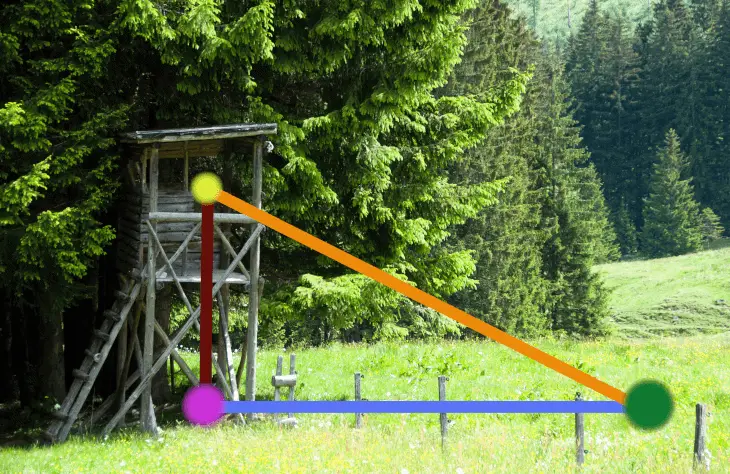Note: Our site links to archery and bowhunting products sold by outside vendors, and we may earn a small commission if you purchase an item after clicking one of these links. Learn more about our affiliate program.
We’ve gotten a few questions about actual distance vs. horizontal distance, and why it’s important when you’re choosing a rangefinder for your next hunt, so in this post, we’ll offer a quick explanation.
If you already understand these concepts, or if geometry and/or physics bore or frustrate you—just remember that when shooting from an elevation, you need go to the features on your rangefinder and select “horizontal distance,” and you should be good to go.
So: actual distance vs. horizontal distance.
Sometimes, you’ll come across game, and it’ll be right in front of you, on an even plane. In other words, you’re on flat land—there’s no incline/decline between you and your game. That happens often with turkey. You grab your rangefinder, measure the distance, and then aim accordingly. If your game is 12 yards in front of you, you use the sight pin in your bow sight and aim for 12 yards. That 12 yards is the actual distance to your target, because your target is 12 yards in front of you.
But in addition to being the actual distance, that 12 yards is also the “horizontal distance” between you and your game. “Horizontal distance” is the distance between you and your game when you’re on the same plane. When you’re shooting at a target and the target is on the same plane as you, your actual distance from your target and your horizontal distance from your target are the same.
When you’re shooting from an elevated position, though—from the top of a hill, or from a tree stand—your actual distance and your horizontal distance are no longer equal.
Let’s take a look at the following (not-so-elegant) image to see what’s going on. And, we apologize in advance for the crappy image—we’re archers, not artists, and this is the best we could do:

Let’s say you’re standing at the base of the tree stand, right where the purple dot is. You see a deer, represented by that green dot, and it’s 12 yards in front of you. The actual distance between you and the deer is 12 yards, and the horizontal distance is 12 yards, too, because you’re on the same plane.
Now let’s say you want to climb the tree stand. Now you’re represented by the yellow dot up in that tree stand. The deer stays still, for some reason, and he’s still the green dot. As you can see, you’re now a little farther away from the deer, because you’re at an elevated angle. Now you’re 13 yards away from the deer—that’s your actual distance from the deer.
Your horizontal distance, however—your distance from the deer if you remained on the same plane—remains 12 yards.
Now here’s the important part: when you’re shooting at a target from an elevation, you want to set your sight using the horizontal distance, and not the actual distance. That is, you aim at your target as though it were 12 yards away (which is the horizontal distance) instead of 13 yards away (which is the actual distance).
So why would you do that? It seems a little counter-intuitive. Well, here’s where physics comes into play.
While your arrow may be travelling 13 yards through the air (the actual distance), gravity is only affecting it over 12 yards (the horizontal distance). When gravity pulls the arrow back towards the earth, it does so based on the amount of the arrow’s horizontal travel, and that’s why you need to aim using horizontal distance. It seems odd, but—well, there’s no arguing with physics. (By the way, if you’d like to read more, here’s a great (albeit brief) post from Bow hunter Ed that discusses what we just wrote about).
So, let’s tie all this together with rangefinders:
Rangefinders usually allow you to scan targets for their actual distance from you, and as we mentioned above, they often have an additional feature that allows for angle compensation, which will display your horizontal distance from the target when you’re up in a tree stand or on a hill. If you’re shooting at a target on flat land, you can use the actual distance feature, and if you’re shooting at a target from an elevated position, you can use the horizontal distance feature.
OK! There you go—we hope that helps! Good luck, be safe, and happy ranging!




